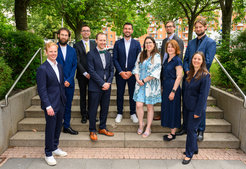Jonas Puchmayr and Philipp Ulbl awarded the Otto Hahn Medal
The Max Planck Society (MPG) honors the two IPP physicists for their outstanding doctoral theses.
With the Otto Hahn Medal, the MPG honors up to 30 young scientists every year for outstanding scientific achievements in connection with their dissertations. This year, Dr. Jonas Puchmayr (3rd from left in the picture) and Dr. Philipp Ulbl (4th from left in the picture) from the Max Planck Institute for Plasma Physics (IPP) in Garching were among the 28 award winners. The Otto Hahn Medal was awarded at the annual meeting of the Max Planck Society on June 25, 2025 in Magdeburg.

In his dissertation, Jonas Puchmayr investigates how external three-dimensional magnetic perturbation fields can attenuate or completely suppress the occurrence of edge-localized modes (ELMs) - explosive particle and energy bursts at the plasma edge. Using magnetohydrodynamic (MHD) simulations, he analyzes how magnetic perturbation fields influence edge stability. To this end, he has extended the CASTOR3D simulation code and shown for the first time where and why edge-localized instabilities occur in realistic tokamak plasmas distorted by magnetic perturbation fields. The results show: Although magnetic perturbation fields can effectively control ELMs, they also reduce the maximum stable edge pressure that can be achieved.
Title of the awarded dissertation:
“Magnetohydrodynamic stability analysis of non-axisymmetric tokamak plasmas using the linear visco-resistive stability code CASTOR3D”
Philipp Ulbl dealt with the simulation of plasmas in his doctoral thesis. The focus is on the edge region of the plasma - a zone in which turbulence and particle collisions occur particularly strongly and play a major role in energy confinement and wall loading. Ulbl is expanding the GENE-X simulation code, which was specially developed for modeling such plasma turbulence in complicated reactor geometry. A new addition is an advanced model for particle collisions, i.e. the Lenard-Bernstein/Dougherty model (LBD). This allows the impact processes in the cooler plasma edge to be calculated much more accurately. Using experiments at the TCV-Tokamak in Lausanne, Ulbl shows that this new model can realistically reproduce the measurements.
Title of the awarded dissertation:
“Collision Models for Gyrokinetic Simulations of Edge Turbulence in Fusion Plasmas”
